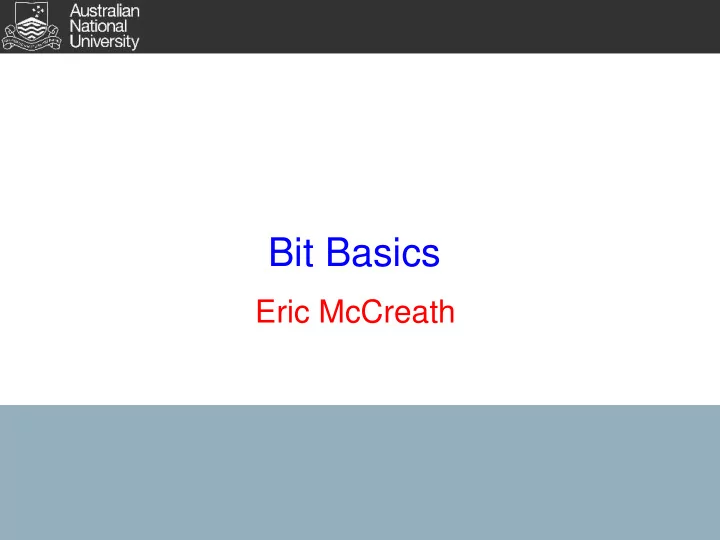

Bit Basics Eric McCreath
Bit Basics A bit (Binary digIT) is single unit of binary storage. A bit is normally grouped with other bits to represent data or information. 4 bits form a nibble 8 bits form a byte (e.g. 10100001 or 0xA1 in hex) Bytes are grouped to form a word. These would normally be 1, 2, 4, or 8 bytes. The size of a word depends on processor architecture. Main memory can be thought of as a large array of bytes. Often data needs to be properly aligned on byte boundaries for a processor to use it efficiently. 2
Kilobyte, Megabyte, Gigabyte When communicating with others about amounts of memory one needs to be careful as there are a number of different standards. The standard being used depends on the context. CCA ShareALike http://en.wikipedia.org/wiki/Megabyte 3
Storage on Modern Computers My current desktop machine has: 6144 KiB cache 3.7 GiB main memory 11.0 GiB swap space reserved on the hard disk 283GiB of space on the hard disk CD-ROM stores around 703 MiB DVDs store from 4.3 to 8.0 GiB 4
Mbps, MIPS and FLOPS Mbps - mega bits per second (1Mbps = 1000000 bits per second) MIPS - million instructions per second. often a poor measure of processor performance this value depends greatly on which instructions are executed FLOPS - floating-point operations per second 5
Characters Characters can be stored using a number. Standard tables have been created to determine which particular character a number represents. There are a few different standards ASCII - American Standar Code for Information Interchange a 7 bit encoding which has a table of 128 characters. See man ascii EBCDIC - Extended Binary Coded Decimal Interchange Code an 8 bit encoding used mainly on IBM mainframes UTF-8 - a variable width standard that can represent Unicode characters and is backward compatible with ASCII. 6
Strings Strings are an artifact of the programming language Strings are normally stored as an array of characters with a null character (or 0) terminating them What does the following mean? 0x43 0x4F 0x4D 0x50 0x32 0x33 0x30 0x30 0x00 7
Endianness Endianness refers to the order, the bytes within a single word are stored within main memory A big-endian machine will store the most significant byte first (lowest address order). Processors include Motorala 6800, SPARC A little-endian machine will store the least significate byte first (lowest address order). Processors include x86, DEC Alpha, and Atmel AVR Some bi-endian hardware can be set so it can do either big-endian or little-endian on particular memory segments. These include ARM, PowerPC, MIPS, and IA-64 8
Endianness Generally a programmer will not care about this order as long as it is consistent. However, it becomes important when computers are connected via a network or share binary data Suppose we have a 32-bit machine and we stored the integer value for 10 at address 0xA0. With a little-endian and big-endian machine we store the following: 9
Recommend
More recommend